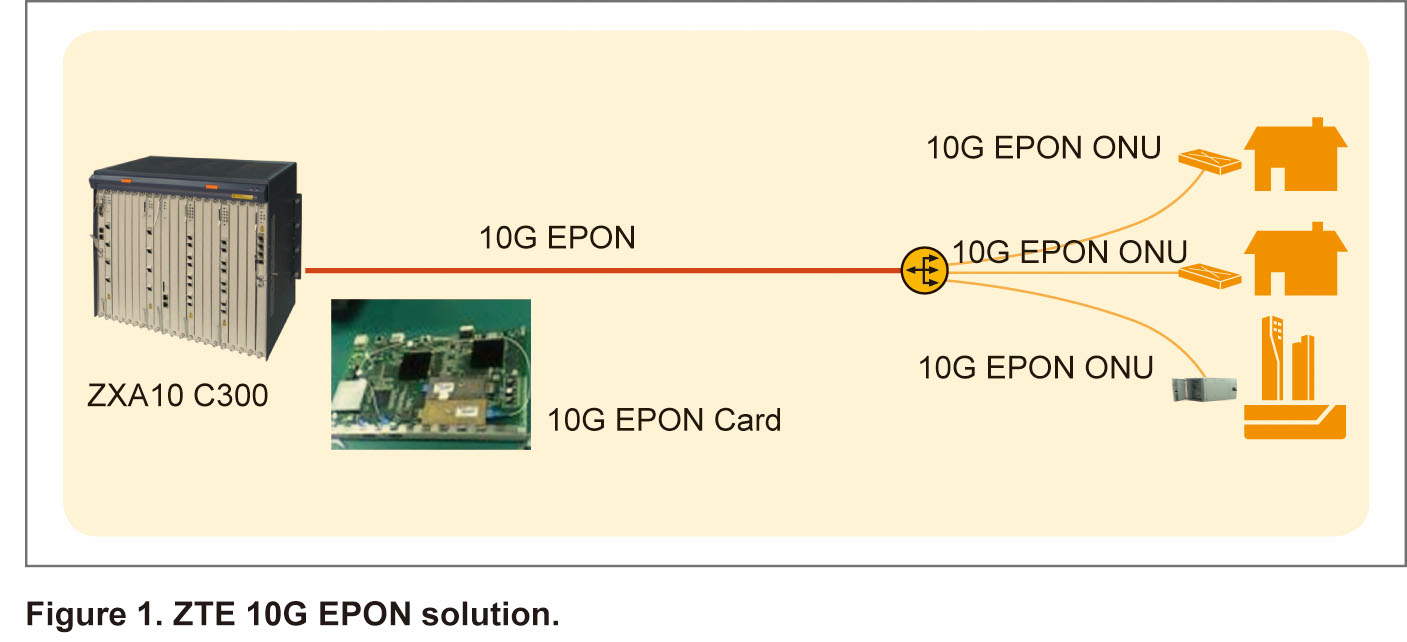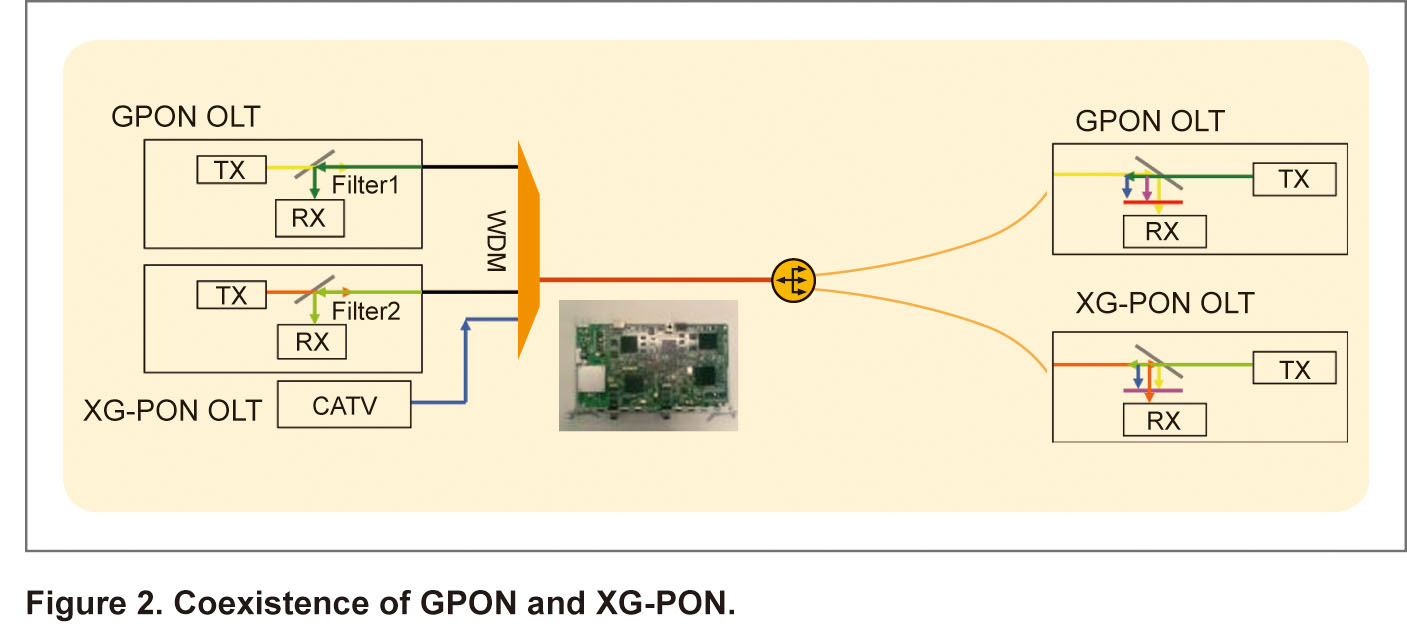Towards Next Generation Networks with Future Proof xPON Solutions
EPON and GPON, both of which belong to the same generation of technology, can provide 1G/2G bandwidth. With huge-stream broadband services like IPTV, HDTV, 3DTV and online game play, subscriber bandwidth requirements are predicted to increase in magnitude every five years, accelerating quickly. The bandwidth requirement per subscriber, for example, is estimated to reach 50–100Mbps when mid-term and long-term development trends are taken into account. However, in current EPON and GPON interfaces, bandwidth bottlenecks have begun to appear. To address this problem, IEEE and ITU-T have put forward Next-Generation Passive Optical Network (NG-PON).
Progress of NG-PON Standards
IEEE 10G EPON
10G EPON was formally standardized and published in the IEEE 802.3av in September 2009. The IEEE 802.3av task force focused on defining a new physical layer, keeping the MAC, MAC control and all the layers above unchanged to the greatest possible extent. The 802.3av standard has two core features: it expands the uplink/downlink bandwidth of the 802.3ah standard to 10Gbps, and it has good compatibility, allowing for the coexistence of 10G EPON ONU and 1G EPON ONU on the same ONU. This provides maximum protection of the operator’s investment. 10G EPON—an NG-PON technology featuring high bandwidth and good compatibility—will be widely employed in the next few years.
FSAN/ITU-T NG-PON
NG-PON is defined in the ITU-T G.987 series. NG-PON standardization is currently being accelerated and all documentation on XG-PON1 standards are expected to be published in 2011. The evolution of NG-PON can be divided by FSAN/ITU-T into two phases: NG-PON1 and NG-PON2. NG-PON1 is a mid-term upgrade from the GPON system, and is backwardly compatible with existing fiber installations. It can be further divided into two generations: XG-PON1 and XG-PON2, which are differentiated by the uplink data rate. NG-PON2, on the other hand, is a long-term solution with an entirely new optical network type—such as WDM PON.
ZTE NG-PON Solution
Drawing on a wealth of experience in access network installations, in 2008, ZTE launched its ZXA10 C300—the world’s first unified NG-PON platform supporting GPON, EPON, P2P, as well as the emerging next generation IEEE 10G EPON and FSAN/ITU-T NG-PON in a single shelf. ZTE’s next generation FTTx solution on the C300 platform offers the following features:
■ Service provision: It can carry CATV, IPTV, voice, data, and mobile services, helping operators transform themselves into full-service providers.
■ Equipment support: It supports up to 16,384 subscribers in a single shelf with a maximum reach of 60km; allows mixed insertion of a variety of PON boards like GPON, EPON, P2P, 10G EPON, 10G GPON and WDM PON to ensure smooth evolution to NG-PON (while protecting operators’ investments); and guarantees QoS, security control, and Zero-Touch management and maintenance.
■ Access mode: It supports all major FTTx access modes including FTTH, FTTB, FTTC and FTTO. It also supports mobile backhaul to meet operator requirements for various application scenarios.
ZTE 10G EPON
ZTE began pre-research into 10G EPON as early as 2006. It ascertained the requirements of major operators at home and abroad, and cooperated with PON chip manufactures, optical module manufacturers, and analog chip makers to jointly deliver an ideal 10G EPON solution (see Figure 1).

ZTE, one of the leading advocates of 10G EPON, is actively involved in drafting 10G EPON standards, and serves as the editor for IEEE802.3av 10G EPON. So far, it has made over 20 technical contributions and given 100 technical comments in 10G EPON standardization meetings.
ZTE launched a prototype of the world’s first 10G EPON equipment in October 2008. It launched a commercial trial of asymmetrical 10G EPON equipment in May 2009, and a commercial trial of symmetrical 10G EPON equipment in October 2009. At present, ZTE’s 10G EPON products are being commercially used by China Mobile and China Telecom. These products have evolved smoothly from existing xPON equipment, and are helping the operators greatly enhance access bandwidth and service access capabilities of their networks.
ZTE NG-PON
ZTE is also deeply involved in pre-research work on NG-PON. It actively participates in drafting NG-PON standards and serves as the editor for ITU-T G.987 NG-PON. It is leading the industry in the research and development of 10G GPON and WDM PON.
ZTE has developed prototype equipment based on the XG-PON1 standard that can meet operator demands for XG-PON1 tests (including PMD verification in the FTTH scenario). It plans to launch the commercial trial of XG-PON1 cards based on the ZXA10 C300 platform in Q3, 2010. Figure 2 shows the coexistence of GPON and XG-PON.

Furthermore, ZTE has a prototype of RSOA-based pure WDM PON equipment and a prototype of hybrid WDM PON equipment, and plans to launch the commercial trial of WDM PON cards based on the ZXA10 C300 platform in Q2, 2010.
Additionally, ZTE has initiated pre-research work on NG-PON2, including OCDMA PON, OFDM PON, and ECDMA PON.
Advantages of ZTE NG-PON Platform
ZTE’s unified NG-PON platform, ZXA10 C300, has the following advantages:
■ Lower power consumption and carbon footprint: ZXA10 C300 can reduce power consumption by 41% due to ASIC & PCB design and innovative methods of setting boards, ports and modules at idle status.
■ Higher site savings: ZXA10 C300 offers a higher density of PON modules, allowing 16,384 users to share the same platform. It also offers longer coverage with a range up to 60km. Compared to traditional OLT designs, ZXA10 C300 combines the benefits of density and coverage to provide higher OPEX savings (as fewer sites are needed).
■ Future proofness: Smooth evolution to 10G EPON and/or NG-PON is possible with ZXA10 C300; only one new module is needed for the upgrade to 10G EPON or NG-PON. This enables additional CAPEX savings compared to a traditional design—which requires the change of heavy hardware in the transition to 10G EPON and/or NG-PON.
■ Industry recognition: Being an xPON ONU, ZXDSL 9806H received two prestigious industry awards: the Convergence World Award in the category of “Best Green Innovation” (for its first-class performance at the SOFNET Forum in London, April 2008), and the Infovision Award in the category of “Best Access Network Technologies and Services” (at the Broadband World Forum Europe in Berlin, October 2007).
Conclusion
ZTE is committed to developing innovative NG-PON products. It is actively involved in NG-PON standardization in both the IEEE and ITU-T, and is the editor for IEEE802.3av and ITU-T G.987. ZTE is pioneering mature and commercialized 10G EPON products, and also takes a leading position in the field of XG-PON1 and WDM PON. Its ZXA10 C300 is the industry’s first NG-PON integrated platform that can help operators smoothly evolve to NG-PON networks while protecting their investments.